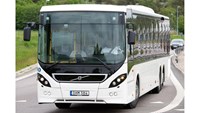
Spending many hours behind the wheel every day, bus drivers often suffer strain in the shoulders, neck and arms. In order to reduce the risk of work-related injuries, last year Volvo Buses introduced Volvo Dynamic Steering (VDS), which makes manoeuvring a bus considerably easier. Now a scientific study has been published that confirms the system’s positive effects.
The study carried out by VTI, the Swedish National Road and Transport Administration, examined muscle strain while driving both with and without VDS, and recorded how much the driver benefits from the system. In the tests, activity in the various muscle groups was measured in left turns, right turns, while negotiating a roundabout and when driving straight ahead.
Significant reduction in muscular strain
The results reveal that on average, VDS cuts muscular strain by 20 to 30 per cent, for certain manoeuvres by up to 70 per cent.
“There’s no doubt that this type of system improves the driver’s working environment. Many drivers experience pain in their joints and muscles, and it is obvious that they benefit from a system of this sort,” says Dr Anna Anund, associate professor and head of research at VTI.
The study also reveals that female drivers, who generally strain more muscles when manoeuvring a bus, benefit as much from VDS as male drivers do.
Appreciated by drivers
After the tests, all 20 drivers reported that they would benefit immensely from VDS in their everyday work and that VDS can reduce muscular pain, above all in the shoulders.
“The longer the tests ran, the more positive the drivers were to the system. This is something they really want,” says Dr Anund.
The fact that VDS is also in demand by customers is reflected in the sales figures. One year after its introduction, more than half of Volvo’s long-distance buses sold in Europe are fitted with VDS. As of the autumn of 2017 the system is also available on Volvo’s city and intercity buses.
“The VTI study confirms the positive effects of Volvo Dynamic Steering for drivers both on long-distance routes and in urban driving. With the introduction of VDS on our city buses too, many more drivers will be able to handle tight cornering, roundabouts and other demanding manoeuvres in a far safer and more relaxed way,” says Volvo Buses ergonomics expert Maria Gink Lövgren.
Both VDS and the VTI study are presented in greater detail at the 2016 IAA trade fair in Hannover from 22 to 29 September.
Brief facts about Volvo Dynamic Steering
- VDS automatically compensates for unevenness in the road surface and eliminates vibration and involuntary steering wheel movement.
- When driving at low speeds, steering is about 75 per cent lighter. What is more, steering is easier since the steering wheel automatically returns to the dead-ahead position when the driver lightens his or her grip on the wheel.
- At higher speeds, the bus maintains directional stability even if the road surface is uneven.
- In 2015 Volvo Dynamic Steering received first prize in the “Safety” category of the European Coach & Bus Week (ECW) competition.
About Volvo Buses.jpg)
Volvo Buses is a leading manufacturer of buses and coaches. With R&D centres in Europe, Asia and the Americas we reinforce our global offers with local expertise and presence.
Throughout our entire organisation we focus on Volvo’s core values: Quality, Safety and Care for the Environment and we express this in the brand promise Driving Quality of Life.
Our success in bringing hybrid technology and electric propulsion to the market is an evidence our leadership and competence in this field.
Transporting people means a certain responsibility in terms of safety and here Volvo has a solid reputation. New features and systems are continuously introduced and our R&D plan for safety technology stretches over decades.
In total we are more than 7,000 dedicated people, annually delivering more than 10,000 vehicles, all of them in the class over 12 tonnes. We are active all over the world and our service network includes more than 140 countries




Comments
There are no comments yet for this item
Join the discussion